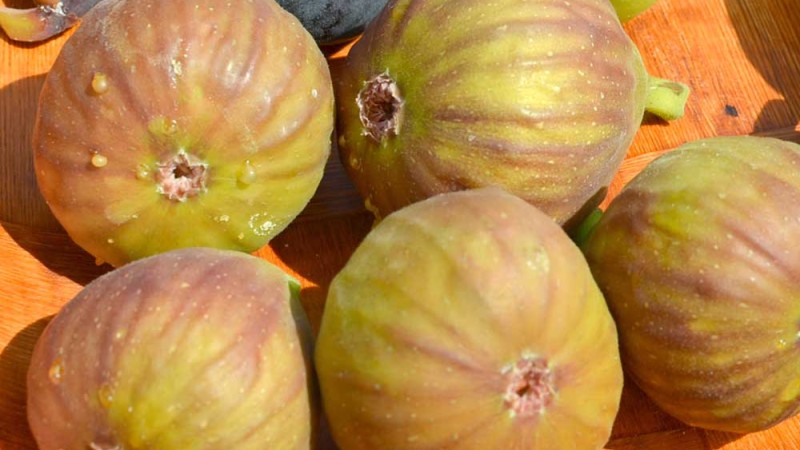
Figovník (Ficus carica) je opadavý ker, alebo malý strom, pôvodom zo Stredomoria, západnej a južnej Ázie. Pestovanie figovníka je možné všade tam, kde sa bežne darí viniču. Okrem toho že figovník plodí lahodné a sladké ovocie, pôsobí celá rastlina vďaka jej atraktívnym listom navyše veľmi dekoratívne a vytvára vo vašej záhrade slnečnú atmosféru Stredomoria.
Na výsadbu do voľnej pôdy si zvoľte odrodu dostatočne odolnú voči mrazom. Dnes je v ponuke mnoho figovníkov, ktoré túto podmienku spĺňajú, líšia sa vzrastom, veľkosťou a kvalitou plodov aj úrodnosťou. Niektoré odrody plodia iba raz v hlavnej sezóne, iné poskytnú úrodu dvakrát v roku. Figovníky nepotrebujú opeľovača, bude nám preto na produkciu plodov stačiť aj jedna rastlina. Aby nám figovník každoročne bohato plodil, sú tu isté zásady, ktoré je potrebné dodržať.
Do voľnej pôdy vysádzame aspoň dvojročné rastliny
V našich klimatických podmienkach sa do voľnej pôdy vysádzajú aspoň 2-ročné silné a rozkonárené rastliny. Jednoročné rastliny si najskôr predpestujte v kvetináči s objemom 5-10 litrov a prezimujte po opadnutí listov vo svetlej miestnosti bez mrazu alebo v pivnici. Nasledujúci rok na jar presaďte rastlinu do väčšieho kvetináča. Figovník prinesie v kvetináči prvú úrodu už na druhý rok. Kmeň figovníka musí zosilnieť na priemer 6-7 cm aby bol úplne mrazuvzdorný. Inak môže rastlina počas tuhej zimy a na nechránenom stanovišti vymrznúť až po zem. V každom prípade, ak by došlo k vymrznutiu, korene vždy prežijú. Takže v prípade vymrznutia nadzemnej časti vyženie na jar zo zeme nové výhonky, na ktorých stihne ešte v ten istý rok aj zaplodiť.
Kde vysádzať figovník
Slnečné miesto pri južnej stene je ideálne miesto na výsadbu. Tu bude chránený pred severným vetrom a zvýši to jeho šancu na dobré prečkanie zimy. Minimálne 6 – 8 hodín priameho slnečného žiarenia podporí zdravý rast a zabezpečí úrodu. V zime sa osvedčilo zateplenie figovníka. Bežnými metódami sú mulčovanie koreňov, obalenie stromu vrecovinou alebo inou priedušnou látkou.
Požiadavky na pôdu
Figovník vytvára plytký ale široko sa rozprestierajúci koreňový systém, ktorý svojou šírkou presahuje aj priemer koruny. Preferuje dobre priepustnú, mierne vápnitú pôdu bohatú na humus. Ideálne je, ak je pôda mierne kyslá s pH 5,5 až 6,5. Dobrá drenáž je kľúčová na zabránenie hniloby koreňov, preto sa uistite, že pôda nezadržiava prebytočnú vodu. Po zakorenení znesie figovník bez problému aj letné sucho.
Hnojenie
Ak figovník rastie v kvalitnej pôde prirodzene bohatej na organickú hmotu a živiny, potom úrodu prináša aj bez pravidelného hnojenia. Ale v chudobnej pôde je potrebné figovník pravidelne hnojiť kombináciou minerálnych a organických hnojív, inak nedokáže rásť ani prinášať dostatok ovocia. Figovník hnojíme pravidelne počas vegetačného obdobia, ideálne od jari do konca leta. Vhodné je použiť organické hnojivá, ako kompost alebo hnoj, zapracované do pôdy na jar, a tekuté hnojivá s vyšším obsahom draslíka od apríla do júla. Na jeseň je možné použiť zelené hnojenie. Figovník sa dá jednoducho pestovať aj vo veľkých kvetináčoch. Stačí pravidelná zálievka s prídavkom tekutého hnojiva a môžete dosiahnuť slušnú úrodu aj na malom priestore v klimaticky menej priaznivých podmienkach.
Rez figovníka
Figovník môžete tvarovať buď ako krík alebo ako stromček. Udržiavací rez sa vykonáva počas vegetačného pokoja skoro na jar (február alebo začiatok marca) pred pučaním a umožňuje lepšiu viditeľnosť štruktúry konárov. Zamerajte sa na odstránenie odumretého, chorého alebo poškodeného dreva, ako aj konárov, ktoré sa krížia alebo rastú dovnútra. Dosiahneme tým otvorenú, vzdušnú štruktúru, ktorá umožní slnečnému žiareniu a vzduchu dostať sa do všetkých častí stromu. Pri starších figovníkoch zrežte časť dlhých, neplodných konárov, aby ste podporili nový rast. Odstráňte konkurenčné výhony vyrastajúce pri báze stromu. Úplné zrezanie sa odporúča pre figovník, ktorého nadzemná časť v dôsledku silných mrazov vymrzla.
Letný rez sa odporúča pre bohatšie plodenie. V lete skracujte nové výhonky na 4-5 listov, aby ste podporili rovnomerné rozvetvovanie a vývoj plodov. Pri strihaní pracujte od základne stromu smerom nahor, aby ste sa vyhli stekaniu miazgy. Črepníková rastlina má tiež rada strih, pričom mladšiu rastlinu by ste mali strihať alebo zastrihávať častejšie, aby ste dosiahli silný rast.
Ale s prerezávaním by ste to nemali preháňať. Čím viac budete figovník rezať, tým viac sily bude rastlina vynakladať na tvorbu nových výhonov a listov na úkor produkcie plodov.
Zber, skladovanie a spracovanie fíg
Väčšina fíg pestovaných vonku je zrelá na konci leta. Plody môžete zbierať hneď ako dozrievajú. Figy sú zrelé, keď sa stonka ohne a plody ovisnú. Čerstvo obraté figy vydržia v chladničke 3 až 5 dní. Figy sú najchutnejšie, keď sú čerstvo odtrhnuté a zohriate slnkom. Ak odoláte pokušeniu, plody s tenkou šupkou môžete vcelku sušiť v sušičke na ovocie, alebo z čerstvých plodov uvariť lahodný džem. Figy môžeme nakrájať do šalátov, jogurtov alebo dezertov. Výborne chutia v kombinácii so syrom, orechmi alebo sušenou šunkou. Figy sa dajú piecť, grilovať alebo zapekať. Čerstvé figy je možné aj zmraziť pre neskoršie použitie.
Liečivé účinky a nutričná hodnota fíg
Plody figovníka sú účinné pri srdcovo-cievnych ochoreniach, málokrvnosti, únave, ako močopudný prostriedok i prostriedok proti zápche. Odvar fíg v mlieku sa používa na liečbu kašľa, bolestí v hrdle, pri angíne a presilených hlasivkách. Obsahujú tiež ficín, čo je enzým štiepiaci bielkoviny, podobne ako papaín v papáji alebo bromelín v ananáse. Vďaka nemu urýchľujú trávenie a vylučovanie. Kvôli vysokej zásaditosti sa hodia na neutralizovanie kyslých potravín, ako je mäso, údeniny, biele pečivo a cukor. V skutočnosti sú figy najlepším prírodným preháňadlom. Obsahujú veľa vlákniny, a to ako rozpustnej (pektín), ktorá znižuje hladinu cholesterolu, tak nerozpustnej, ktorá zlepšuje črevnú peristaltiku a chráni tak pred zápchou a inými črevnými poruchami. Slúžia preto, ako mierne, nenávykové a bezpečné prírodné preháňadlo. Figy zároveň črevá i čistia a zbavujú usadených škodlivín. Rovnaký čistiaci účinok majú aj na obličky a močové cesty. Pôsobia mierne močopudne a dokážu rozpúšťať usadené škodliviny v obličkách vo forme tzv. obličkových kameňov či piesku. Pôsobia proti infekciám v hrudníku, zmierňujú kašeľ, zlepšujú vykašliavanie a zmäkčujú dýchacie cesty.











